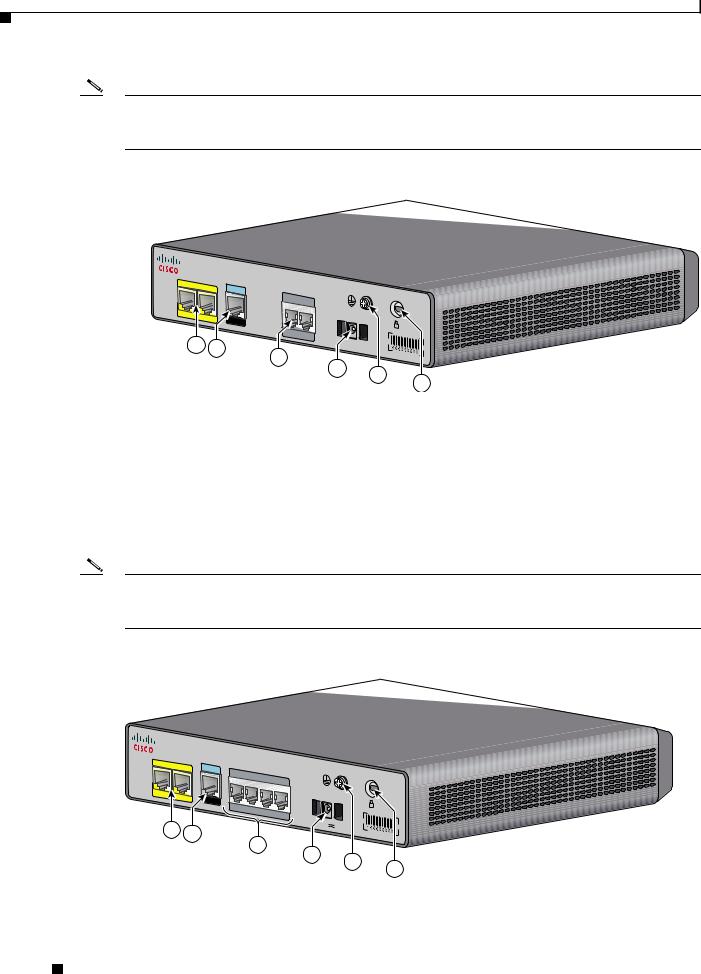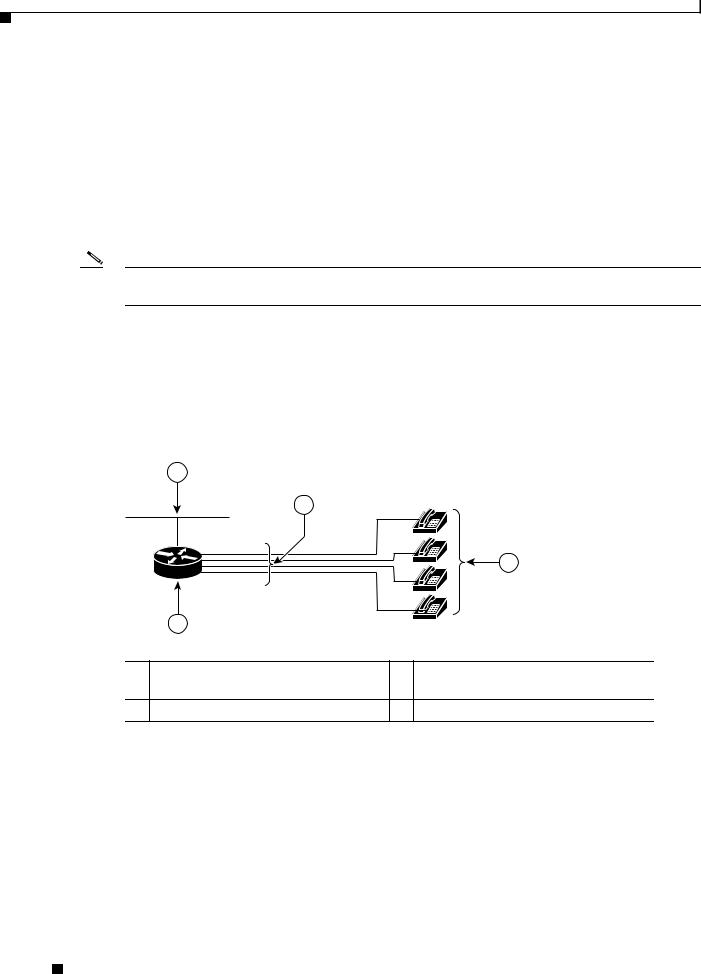Cisco VG202, VG202XM, VG204XM, VG204 User Manual

Cisco VG202, Cisco VG202XM,
Cisco VG204, and Cisco VG204XM
Voice Gateways Software Configuration
Guide
Americas Headquarters
Cisco Systems, Inc. 170 West Tasman Drive
San Jose, CA 95134-1706 USA http://www.cisco.com Tel: 408 526-4000
800 553-NETS (6387) Fax: 408 527-0883
Text Part Number: OL-16191-01
THE SPECIFICATIONS AND INFORMATION REGARDING THE PRODUCTS IN THIS MANUAL ARE SUBJECT TO CHANGE WITHOUT NOTICE. ALL STATEMENTS, INFORMATION, AND RECOMMENDATIONS IN THIS MANUAL ARE BELIEVED TO BE ACCURATE BUT ARE PRESENTED WITHOUT WARRANTY OF ANY KIND, EXPRESS OR IMPLIED. USERS MUST TAKE FULL RESPONSIBILITY FOR THEIR APPLICATION OF ANY PRODUCTS.
THE SOFTWARE LICENSE AND LIMITED WARRANTY FOR THE ACCOMPANYING PRODUCT ARE SET FORTH IN THE INFORMATION PACKET THAT SHIPPED WITH THE PRODUCT AND ARE INCORPORATED HEREIN BY THIS REFERENCE. IF YOU ARE UNABLE TO LOCATE THE SOFTWARE LICENSE OR LIMITED WARRANTY, CONTACT YOUR CISCO REPRESENTATIVE FOR A COPY.
The Cisco implementation of TCP header compression is an adaptation of a program developed by the University of California, Berkeley (UCB) as part of UCB’s public domain version of the UNIX operating system. All rights reserved. Copyright © 1981, Regents of the University of California.
NOTWITHSTANDING ANY OTHER WARRANTY HEREIN, ALL DOCUMENT FILES AND SOFTWARE OF THESE SUPPLIERS ARE PROVIDED “AS IS” WITH ALL FAULTS. CISCO AND THE ABOVE-NAMED SUPPLIERS DISCLAIM ALL WARRANTIES, EXPRESSED OR IMPLIED, INCLUDING, WITHOUT LIMITATION, THOSE OF MERCHANTABILITY, FITNESS FOR A PARTICULAR PURPOSE AND NONINFRINGEMENT OR ARISING FROM A COURSE OF DEALING, USAGE, OR TRADE PRACTICE.
IN NO EVENT SHALL CISCO OR ITS SUPPLIERS BE LIABLE FOR ANY INDIRECT, SPECIAL, CONSEQUENTIAL, OR INCIDENTAL DAMAGES, INCLUDING, WITHOUT LIMITATION, LOST PROFITS OR LOSS OR DAMAGE TO DATA ARISING OUT OF THE USE OR INABILITY TO USE THIS MANUAL, EVEN IF CISCO OR ITS SUPPLIERS HAVE BEEN ADVISED OF THE POSSIBILITY OF SUCH DAMAGES.
Cisco and the Cisco logo are trademarks or registered trademarks of Cisco and/or its affiliates in the U.S. and other countries. To view a list of Cisco trademarks, go to this URL: www.cisco.com/go/trademarks. Third-party trademarks mentioned are the property of their respective owners. The use of the word partner does not imply a partnership relationship between Cisco and any other company. (1110R)
Cisco VG202, Cisco VG202XM, Cisco VG204, and Cisco VG204XM Voice Gateways Software Configuration Guide
Copyright © 2008-2013 Cisco Systems, Inc. All rights reserved.

|
|
|
|
|
|
C O N T E N T S |
|
|
Preface v |
|
|
|
|
|
|
Understanding Interface Numbering and Cisco IOS Software Basics 1-1 |
||||
C H A P T E R |
1 |
|||||
|
|
About the Voice Gateways |
1-1 |
|
|
|
|
|
Port Numbering Conventions |
1-1 |
|
|
|
|
|
Understanding Cisco IOS Software Basics |
1-3 |
|||
|
|
About Cisco IOS Software 1-3 |
|
|
||
|
|
Getting Help |
1-4 |
|
|
|
|
|
Command Modes 1-4 |
|
|
|
|
|
|
Undoing a Command or Feature |
1-5 |
|
||
|
|
Saving Configuration Changes |
1-5 |
|
||
|
|
Upgrading to a New Cisco IOS Release |
1-6 |
|||
|
|
Typical Voice Gateway Deployment Scenario |
1-6 |
|||
|
|
Where to Go Next |
1-6 |
|
|
|
|
|
Configuring Your Voice Gateway Using the setup Command 2-1 |
||||
C H A P T E R |
2 |
|||||
|
|
About Configuring Your Voice Gateway 2-1 |
||||
|
|
Preparing to Configure Your Cisco Voice Gateway 2-1 |
||||
|
|
Using the setup Command |
2-2 |
|
|
|
|
|
Completing the Configuration |
2-5 |
|
|
|
C H A P T E R |
3 |
Configuring Your Voice Gateway Using the CLI 3-1 |
|||
|
|
Configuring the Hostname and Password |
3-1 |
||
|
|
Verifying the Hostname and Password |
3-2 |
||
|
|
Configuring Fast Ethernet Interfaces 3-3 |
|
||
|
|
Saving Configuration Changes |
3-5 |
|
|
|
|
Configuring Voice |
|
|
|
C H A P T E R |
4 |
4-1 |
|
|
|
|
|
Prerequisites |
4-1 |
|
|
|
|
Configuring the Voice Interface |
4-1 |
|
|
|
|
Auto-Configuration on the Cisco VG202, Cisco VG202XM, Cisco VG204, and Cisco VG204XM Voice |
|||
|
|
Gateways 4-3 |
|
|
|
|
Restriction for Configuring Auto-Configuration |
4-3 |
|
|
|
|
Cisco VG202, Cisco VG202XM, Cisco VG204, and Cisco VG204XM Voice Gateways Software Configuration Guide |
|
|
|
|
|
|||||
|
|
|
|
|
|
|
OL-16191-01 |
|
|
iii |
|
|
|
|
|
||

Contents
|
Auto-Configuration With a DHCP Server |
4-3 |
|
||||
|
Auto-Configuration Without a DHCP Server |
4-5 |
|||||
|
Configuring the Voice Interface for Cisco Unified Communications Manager 4-7 |
||||||
|
Configuring the MAC Address Convention |
4-10 |
|
||||
|
Configuring Calls |
4-11 |
|
|
|
|
|
|
Call Transfer |
4-11 |
|
|
|
|
|
|
Call Waiting |
4-12 |
|
|
|
|
|
|
Three-Party Conferencing |
4-12 |
|
|
|
||
|
Caller ID 4-12 |
|
|
|
|
|
|
|
Using the ROM Monitor A-1 |
|
|
|
|
|
|
A P P E N D I X A |
|
|
|
|
|
||
|
Entering the ROM Monitor Mode |
A-1 |
|
|
|||
|
About the ROM Monitor Commands |
A-2 |
|
|
|||
|
Listing the ROM Monitor Commands A-3 |
|
|||||
|
Command Descriptions |
A-3 |
|
|
|
||
|
Recovering Boot and System Images |
A-4 |
|
|
|||
|
Using the Configuration Register |
A-5 |
|
|
|
||
|
About Changing the Configuration Register |
A-5 |
|||||
|
Changing the Configuration Register Manually A-5 |
||||||
|
Changing the Configuration Register Using Prompts A-5 |
||||||
|
Using the Console Download Function |
A-6 |
|
|
|||
|
About the Console Download Function |
A-6 |
|
||||
|
Command Description |
A-6 |
|
|
|
|
|
|
Error Reporting |
A-7 |
|
|
|
|
|
Using Debug Commands A-7
Exiting the ROM Monitor Mode A-8
I N D E X
Cisco VG202, Cisco VG202XM, Cisco VG204, and Cisco VG204XM Voice Gateways Software Configuration Guide
|
iv |
OL-16191-01 |
|
|
|

Preface
This preface describes the objectives, audience, and conventions of this document, and where to get the latest version of documentation.
•Document Objectives, page v
•Audience, page v
•Documentation Conventions, page vi
•Accessibility, page vi
•Related Documentation, page vii
•Obtaining Documentation and Submitting a Service Request, page vii
Document Objectives
After installing a Cisco VG202, Cisco VG202XM, Cisco VG204, or Cisco VG204XM voice gateway, use this guide to complete a basic configuration. This guide also contains information on using the Cisco IOS software to perform other configuration tasks, such as configuring a VoIP interface and other features.
This guide does not provide complete configuration instructions. See the Cisco IOS configuration guides and command references for detailed configuration instructions.
Audience
This document is designed for the person who will be responsible for configuring your voice gateway. This guide is intended primarily for the following audiences:
•Customers with technical networking background and experience.
•System administrators who are familiar with the fundamentals of voice gateway-based internetworking, but who might not be familiar with Cisco IOS software.
•System administrators who are responsible for installing and configuring internetworking equipment, and who are familiar with Cisco IOS software.
Cisco VG202, Cisco VG202XM, Cisco VG204, and Cisco VG204XM Voice Gateways Software Configuration Guide
|
OL-16191-01 |
v |
|

Documentation Conventions
Table 1 |
Documentation Conventions |
||
|
|
|
|
Convention |
|
Description |
|
|
|
|
|
boldface font |
|
Commands and keywords. |
|
|
|
|
|
italic font |
|
Variables for which you supply values. |
|
|
|
|
|
[ |
] |
|
Keywords or arguments that appear within square brackets are optional. |
|
|
|
|
{x | y | z} |
|
A choice of required keywords appears in braces separated by vertical bars. You must select one. |
|
|
|
|
|
screen font |
|
Examples of information displayed on the screen. |
|
|
|
||
boldface screen |
Examples of information you must enter. |
||
font |
|
|
|
|
|
|
|
< |
> |
|
Nonprinting characters, for example passwords, appear in angle brackets in contexts where italic font is |
|
|
|
not available. |
|
|
|
|
[ |
] |
|
Default responses to system prompts appear in square brackets. |
|
|
|
|
Note Means reader take note. Notes contain helpful suggestions or references to materials not contained in this publication.
Timesaver Means the described action saves time. You can save time by performing the action described in the paragraph.
Caution Means reader be careful. In this situation, you might do something that could result in equipment damage or loss of data.
Tip Means the following information will help you solve a problem. The tips information might not be troubleshooting or even an action, but could be useful information, similar to a Timesaver.
Accessibility
You can configure the Cisco VG202, Cisco VG202XM, Cisco VG204, and Cisco VG204XM voice gateways by using the Cisco command-line interface (CLI). The CLI conforms to code 508 because it is text based and relies on a keyboard for navigation. You can configure and monitor all functions of the voice gateway through the CLI.
For a complete list of guidelines and Cisco products’ adherence to accessibility, see Cisco Accessibility Products at the following URL:
http://www.cisco.com/web/about/responsibility/accessibility/products
Cisco VG202, Cisco VG202XM, Cisco VG204, and Cisco VG204XM Voice Gateways Software Configuration Guide
|
vi |
OL-16191-01 |
|
|
|

Related Documentation
The documents described here are available online. To be sure that you are obtaining the latest information, you should access the online documentation.
To access online user documentation (in both PDF and HTML formats), go to Cisco.com. Under
Documentation, select Voice and Unified Communications, select Voice Gateway, and then select Cisco VG200 Series Gateways.
•Cisco VG202, Cisco VG202XM, Cisco VG204, and Cisco VG204XM Voice Gateways Hardware Installation Guide
•Cisco VG202, Cisco VG202XM, Cisco VG204, and Cisco VG204XM Voice Gateways Quick Start Guide
•Cisco VG202, Cisco VG202XM, Cisco VG204, and Cisco VG204XM Voice Gateways Software Configuration Guide (this document)
•Regulatory Compliance and Safety Information for the Cisco VG202, Cisco VG202XM, Cisco VG204, and Cisco VG204XM Voice Gateways
Obtaining Documentation and Submitting a Service Request
For information on obtaining documentation, submitting a service request, and gathering additional information, see the monthly What’s New in Cisco Product Documentation, which also lists all new and revised Cisco technical documentation, at:
http://www.cisco.com/en/US/docs/general/whatsnew/whatsnew.html
Subscribe to the What’s New in Cisco Product Documentation as a Really Simple Syndication (RSS) feed and set content to be delivered directly to your desktop using a reader application. The RSS feeds are a free service and Cisco currently supports RSS version 2.0.
vii

Cisco VG202, Cisco VG202XM, Cisco VG204, and Cisco VG204XM Voice Gateways Software Configuration Guide
|
viii |
OL-16191-01 |
|
|
|

C H A P T E R 1
Understanding Interface Numbering and
Cisco IOS Software Basics
•About the Voice Gateways, page 1-1
•Port Numbering Conventions, page 1-1
•Understanding Cisco IOS Software Basics, page 1-3
•Typical Voice Gateway Deployment Scenario, page 1-6
•Where to Go Next, page 1-6
About the Voice Gateways
Cisco VG202, Cisco VG202XM, Cisco VG204, and Cisco VG204XM voice gateways deliver analog voice gateways for the service provider as well as commercial and enterprise unified communication markets. These voice gateways provide voice connectivity to devices such as analog phones, fax machines, and modems.
Cisco VG202, Cisco VG202XM, Cisco VG204, and Cisco VG204XM voice gateways provide support for 2-FXS (Cisco VG202 and Cisco VG202XM) and 4-FXS (Cisco VG204 and Cisco VG204XM) ports, each supporting independent telephone numbers giving you two or four separate lines, and parity with Cisco IOS fax/modem, security, and Session Initiation Protocol (SIP) features. Both voice gateways are configurable with Cisco Unified Communications Manager (CUCM) & Cisco Unified Communications Manager Express (CUCME).
Note Cisco VG202, Cisco VG202XM, Cisco VG204, and Cisco VG204XM voice gateways are fixed voice gateways and do not support interface cards.
Port Numbering Conventions
The Cisco VG202 voice gateway supports two RJ-11 ports and supports two FXS voice ports with two 10/100 Fast Ethernet ports. Figure 1-1 shows the interfaces and ports on the Cisco VG202 voice gateway. All interface ports are on the back of the chassis.
Cisco VG202, Cisco VG202XM, Cisco VG204, and Cisco VG204XM Voice Gateways Software Configuration Guide
|
OL-16191-01 |
1-1 |
|
|
|

Chapter 1 Understanding Interface Numbering and Cisco IOS Software Basics
Port Numbering Conventions
Note The Cisco VG202 and the Cisco VG202XM chassis are identical. The only difference is the model number on the top center. On the Cisco VG202 chassis, the faceplate label says VG202. On the Cisco VG202XM chassis, the faceplate label says VG202XM.
Figure 1-1 Back Panel Feature Locations on the Cisco VG202 Chassis
FastEthernet |
CON |
|
|
|
SOLE |
0/1 |
0/0 |
AUX |
|
||
|
|
|
1 2
VG202 |
|
FXS |
|
0/1 |
0/0 |
|


 SA
SA
3
4 5
6
231880
|
Fast Ethernet port 1, |
|
Serial port—console or |
|
FXS ports |
1 |
Fast Ethernet port 0 |
2 |
auxiliary |
3 |
|
|
|
|
|
|
|
4 |
Power connector |
5 |
Chassis ground connection |
6 |
Kensington security slot |
|
|
|
|
|
|
The Cisco VG204 voice gateway supports four RJ-11ports and supports four FXS voice ports with two 10/100 Fast Ethernet ports. Figure 1-2 shows the interfaces and ports on the Cisco VG204 voice gateway. All interface ports are on the back of the chassis.
Note The Cisco VG204 and the Cisco VG204XM chassis are identical. The only difference is the model number on the top center. On the Cisco VG204 chassis, the faceplate label says VG204. On the Cisco VG204XM chassis, the faceplate label says VG204XM.
Figure 1-2 Back Panel Feature Locations on the Cisco VG204 Chassis
FastEthernet |
CONSOLE |
|
|
|
|
0/1 |
0/0 |
AUX |
|
||
|
|
|
1 2
|
|
VG204 |
|
|
|
FXS |
|
0/3 |
0/2 |
0/1 |
|
|
0/0 |
||
|
|
||
|
|
|
12V DC |
SA |
|
3
4
5
6
231940
Cisco VG202, Cisco VG202XM, Cisco VG204, and Cisco VG204XM Voice Gateways Software Configuration Guide
1-2 |
OL-16191-01 |
|
|

Chapter 1 Understanding Interface Numbering and Cisco IOS Software Basics
Understanding Cisco IOS Software Basics
|
Fast Ethernet port 1, |
|
Serial port—console or |
|
FXS ports |
1 |
Fast Ethernet port 0 |
2 |
auxiliary |
3 |
|
|
|
|
|
|
|
4 |
Power connector |
5 |
Chassis ground connection |
6 |
Kensington security slot |
|
|
|
|
|
|
Port numbering conventions for the Cisco VG202, Cisco VG202XM, Cisco VG204, and
Cisco VG204XM voice gateways are as follows:
•Foreign Exchange Station (FXS) voice port numbering begins at 0/0 and extends to 0/1 for the Cisco VG202 and Cisco VG202XM, and extends to 0/3for the Cisco VG204 and Cisco VG204XM.
•10/100BASE-T Fast Ethernet ports are numbered Fast Ethernet 0/0 and Fast Ethernet 0/1, from right to left.
Understanding Cisco IOS Software Basics
•About Cisco IOS Software, page 1-3
•Getting Help, page 1-4
•Command Modes, page 1-4
•Undoing a Command or Feature, page 1-5
•Saving Configuration Changes, page 1-5
•Upgrading to a New Cisco IOS Release, page 1-6
About Cisco IOS Software
|
|
Understanding these concepts about the Cisco IOS software will save time as you begin to use the CLI. |
|
|
If you have never used Cisco IOS software or if you need a refresher, take a few minutes to read this |
|
|
chapter before you proceed to the next chapter. |
|
|
If you are already familiar with Cisco IOS software, proceed to Chapter 2, “Configuring Your Voice |
|
|
Gateway Using the setup Command.” |
|
|
For a comprehensive view of Cisco IOS configuration fundamentals, see the Cisco IOS Configuration |
|
|
Fundamentals Configuration Guide, Release 12.4. |
|
|
|
Note |
• Your Cisco IOS software release may not support all of the features documented in this document. |
|
|
|
For the latest feature information and caveats, see the release notes for your platform and software |
|
|
release. |
|
|
• Use the Cisco Feature Navigator to find information about platform support and Cisco IOS and |
|
|
Catalyst OS software image support. To access the Cisco Feature Navigator, go to |
|
|
http://www.cisco.com/go/cfn. You do not need an account on Cisco.com to access the Cisco Feature |
|
|
Navigator. |
Cisco VG202, Cisco VG202XM, Cisco VG204, and Cisco VG204XM Voice Gateways Software Configuration Guide
|
OL-16191-01 |
1-3 |
|
|
|

Chapter 1 Understanding Interface Numbering and Cisco IOS Software Basics
Understanding Cisco IOS Software Basics
•The VG202 and VG204 devices support IOS software releases 15.0(1)M or earlier* due to memory limitations. The VG202XM and VG204XM devices will support the latest IOS software release 15.3(2)T and beyond. Earlier releases are not supported on the VG202XM and VG204XM. *Deployments requiring support for secure SCCP based call control are supported using 15.1(4)M IOS release.
Getting Help
Use the question mark (?) and arrow keys to help you enter commands:
• For a list of available commands, enter a question mark:
VG> ?
• To complete a command, enter a few known characters followed by a question mark (with no space):
VG> s?
• For a list of command variables, enter the command followed by a space and a question mark:
VG> show ?
•To redisplay a command you previously entered, press the up arrow key. You can continue to press the up arrow key for more commands.
Command Modes
The Cisco IOS user interface involves different modes. Each command mode permits you to configure different components on your voice gateway. The commands available at any given time depend on which mode you are currently in. Entering a question mark (?) at the prompt displays a list of commands available for each command mode. Table 1-1 lists the most common command modes.
Table 1-1 |
Common Command Modes |
|
|
|
|
|
|
|
|
Command Mode |
Access Method |
VG Prompt Displayed |
Exit Method |
|
|
|
|
|
|
User EXEC |
|
Log in. |
VG> |
Use the logout |
|
|
|
|
command. |
|
|
|
|
|
Privileged EXEC |
From user EXEC mode, |
VG# |
To exit to user EXEC |
|
|
|
enter the enable |
|
mode, use the disable, |
|
|
command. |
|
exit, or logout |
|
|
|
|
command. |
|
|
|
|
|
Cisco VG202, Cisco VG202XM, Cisco VG204, and Cisco VG204XM Voice Gateways Software Configuration Guide
1-4 |
OL-16191-01 |
|
|

Chapter 1 Understanding Interface Numbering and Cisco IOS Software Basics
Understanding Cisco IOS Software Basics
Table 1-1 |
Common Command Modes (continued) |
|
||
|
|
|
|
|
Command Mode |
Access Method |
VG Prompt Displayed |
Exit Method |
|
|
|
|
|
|
Global configuration |
From the privileged |
VG(config)# |
To exit to privileged |
|
|
|
EXEC mode, enter the |
|
EXEC mode, use the |
|
|
configure terminal |
|
exit or end command, |
|
|
command. |
|
or press Ctrl-Z. |
|
|
|
|
|
Interface configuration |
From the global |
VG(config-if)# |
To exit to global |
|
|
|
configuration mode, |
|
configuration mode, use |
|
|
enter the interface type |
|
the exit command. |
|
|
number command, such |
|
To exit directly to |
|
|
as |
|
|
|
|
|
privileged EXEC mode, |
|
|
|
interface fast ethernet |
|
|
|
|
|
press Ctrl-Z. |
|
|
|
0/0. |
|
|
|
|
|
|
|
|
|
|
|
|
Timesaver Each command mode restricts you to a subset of commands. If you are having trouble entering a command, check the prompt, and enter the question mark (?) for a list of available commands. You might be in the wrong command mode or using the wrong syntax.
In the following example, notice how the prompt changes after each command to indicate a new command mode:
VG> enable
Password: <enable password>
VG# configure terminal
VG(config)# interface fastEthernet 0/0
VG(config-if)# line 0 VG(config)# exit
VG#
%SYS-5-CONFIG_I: Configured from console by console
The last message is normal and does not indicate an error. Press Return to get the VG# prompt.
Note You can press Ctrl-Z in any mode to immediately return to enable mode (VG#), instead of entering exit, which returns you to the previous mode.
Undoing a Command or Feature
If you want to undo a command you entered or disable a feature, enter the keyword no before most commands; for example, no ip routing.
Saving Configuration Changes
You need to enter the copy running-config startup-config command to save your configuration changes to NVRAM, so the changes are not lost if there is a system reload or power outage. For example:
VG# copy running-config startup-config
Building configuration...
Cisco VG202, Cisco VG202XM, Cisco VG204, and Cisco VG204XM Voice Gateways Software Configuration Guide
|
OL-16191-01 |
1-5 |
|
|
|

Chapter 1 Understanding Interface Numbering and Cisco IOS Software Basics
Typical Voice Gateway Deployment Scenario
It might take a minute or two to save the configuration to NVRAM. After the configuration has been saved, the following appears:
[OK]
VG#
Upgrading to a New Cisco IOS Release
To install or upgrade to a new Cisco IOS release, see Maintaining System Memory in the Cisco IOS Configuration Fundamentals Configuration Guide, Release 12.2.
Note To simplify network operations and management of Cisco IOS software migration, see the Basics of a Successful Cisco IOS Software Migration.
Typical Voice Gateway Deployment Scenario
Figure 1-3 shows a typical deployment scenario for a Cisco VG202, Cisco VG202XM, Cisco VG204, or Cisco VG204XM voice gateway.
Figure 1-3 |
Analog FXS User Interfaces |
|
|
|
|
1 |
|
|
|
|
|
3 |
|
|
|
|
|
|
4 |
|
|
|
|
272489 |
|
2 |
|
|
|
|
Ethernet |
|
|
Cisco VG204/Cisco VG204XM voice |
1 |
|
|
2 |
gateway |
3 |
RJ-11 cables |
4 |
Analog telephones |
|
Where to Go Next
Now that you have learned some Cisco IOS software basics and seen a typical deployment scenario, you can begin to configure your voice gateway by using the CLI.
Remember that:
•You can use the question mark (?) and arrow keys to help you enter commands.
•Each command mode restricts you to a set of commands. If you have difficulty entering a command, check the prompt and then enter the question mark (?) for a list of available commands. You might be in the wrong command mode or be using the wrong syntax.
Cisco VG202, Cisco VG202XM, Cisco VG204, and Cisco VG204XM Voice Gateways Software Configuration Guide
1-6 |
OL-16191-01 |
|
|

Chapter 1 Understanding Interface Numbering and Cisco IOS Software Basics
Where to Go Next
•To disable a feature, generally enter the keyword no before the command; for example, no ip routing.
•You need to save your configuration changes to NVRAM so that the changes are not lost if there is a system reload or power outage.
Go to Chapter 2, “Configuring Your Voice Gateway Using the setup Command,” to begin configuring your voice gateway.
Cisco VG202, Cisco VG202XM, Cisco VG204, and Cisco VG204XM Voice Gateways Software Configuration Guide
|
OL-16191-01 |
1-7 |
|
|
|

Chapter 1 Understanding Interface Numbering and Cisco IOS Software Basics
Where to Go Next
Cisco VG202, Cisco VG202XM, Cisco VG204, and Cisco VG204XM Voice Gateways Software Configuration Guide
1-8 |
OL-16191-01 |
|
|
